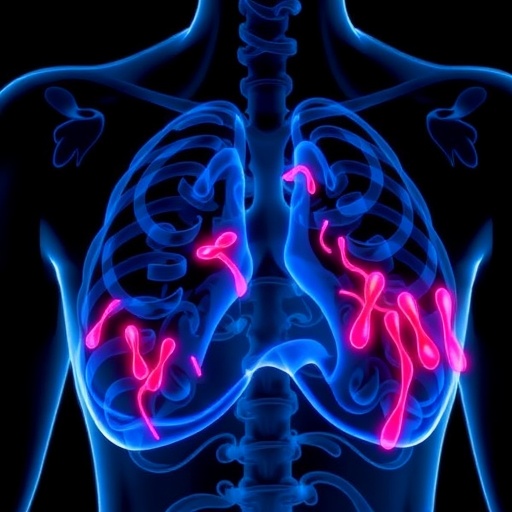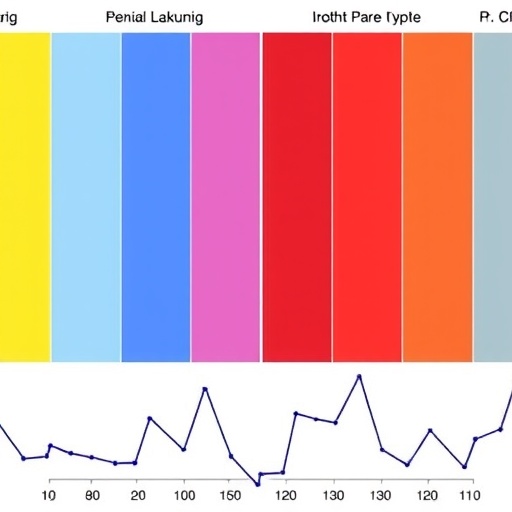In a groundbreaking advancement in breast cancer research, scientists have harnessed the power of cutting-edge machine learning algorithms to pinpoint critical biomarkers intimately linked with distant metastasis. This breakthrough ushers in a new era for oncologists aiming to decode the complex biological signatures that predict the spread of breast cancer, enabling earlier intervention and tailored therapeutic strategies that could transform patient outcomes.
At the heart of this study lies the utilization of two sophisticated machine learning techniques: Boruta and Least Absolute Shrinkage and Selection Operator (LASSO). These algorithms were deftly employed to sift through a myriad of nutritional and inflammatory indicators, isolating those most predictive of distant metastatic risk among breast cancer patients. The integration of such data-driven methodologies marks a significant leap forward from traditional statistical analyses, promising greater precision in biomarker selection.
Researchers analyzed data collected from 348 patients newly diagnosed with breast cancer, rigorously divided into two cohorts: 185 individuals diagnosed with nonmetastatic breast cancer and 163 patients whose cancer had already spread distantly. This balanced approach permitted a comparative analysis of clinical and biological variables across disease stages. The study’s strength is further underscored by its focus on readily measurable biomarkers, bridging the gap between laboratory research and feasible clinical application.
.adsslot_iLUwQOfozD{ width:728px !important; height:90px !important; }
@media (max-width:1199px) { .adsslot_iLUwQOfozD{ width:468px !important; height:60px !important; } }
@media (max-width:767px) { .adsslot_iLUwQOfozD{ width:320px !important; height:50px !important; } }
ADVERTISEMENT
Initial variable screening was conducted using the Boruta algorithm, a data mining technique designed for all-relevant feature selection. Boruta is known for its robustness in filtering through noisy datasets, identifying the strongest signals amidst numerous potential predictors. Following this, the LASSO regression refined the variable list by penalizing less predictive markers, culminating in an optimized model spotlighting the most influential indicators associated with metastatic progression.
This combined machine learning framework distilled five vital biomarkers with significant prognostic implications: the advanced lung cancer inflammation index (ALI), systemic inflammation response index (SIRI), monocyte-to-lymphocyte ratio (MLR), albumin-to-globulin ratio (AGR), and geriatric nutritional risk index (GNRI). These markers, individually and collectively, paint a nuanced picture of the inflammatory and nutritional milieu influencing breast cancer metastasis.
Multivariate logistic regression analyses added depth by quantifying the associations between each biomarker and metastasis risk. Interestingly, elevated levels of systemic inflammation response index and monocyte-to-lymphocyte ratio were linked with increased metastasis risk, highlighting the pivotal role of systemic inflammation in facilitating cancer dissemination. Conversely, higher ALI, AGR, and GNRI values correlated with reduced metastatic risk, underscoring the protective influence of better nutritional status and certain inflammatory profiles.
To further capture complex associations, restricted cubic spline functions were employed. This statistical technique allowed the researchers to model non-linear relationships between biomarkers and metastatic risk, revealing thresholds beyond which changes in biomarker levels exerted disproportionate effects on disease progression. Such nuanced modeling enhances clinical interpretability, enabling practitioners to better gauge risk gradients rather than relying on simplistic cut-offs.
Performance metrics were rigorously assessed using Receiver Operating Characteristic (ROC) curve analysis, demonstrating that the selected biomarkers possess moderate predictive accuracy, with area under the curve (AUC) values hovering around 0.65. While these figures suggest room for improvement, they nevertheless signify a meaningful step towards integrating biomarker-based risk stratification into routine clinical workflows.
The implications of this research are multifaceted. Firstly, it offers a concrete panel of biomarkers amenable to clinical testing, potentially facilitating earlier identification of patients at heightened risk for distant metastasis. This stratification can inform the judicious allocation of aggressive treatments, sparing low-risk patients from overtreatment and its accompanying toxicities. Secondly, it highlights the critical intersection of inflammation and nutrition in cancer progression, opening avenues for adjuvant therapies targeting these modifiable factors.
Moreover, the study champions the fusion of computational intelligence with clinical oncology, exemplifying how machine learning can unravel complex biological interplays that evade classical analysis. As datasets in oncology continue to expand exponentially, such algorithmic approaches will become indispensable in distilling actionable insights from high-dimensional data landscapes.
While the findings are promising, the authors acknowledge certain limitations that beckon further inquiry. The moderate AUC values imply that additional biomarkers or integrative models incorporating genetic, metabolic, or imaging data could bolster predictive power. Prospective validation in larger, diverse cohorts will also be paramount to confirm clinical utility and generalizability across varying patient populations.
This pioneering work not only enriches the biomarker repertoire for breast cancer metastasis but also sets a methodological precedent for future oncology research. The ability to precisely identify patients at risk of systemic disease spread is a clinical holy grail — one that could ultimately translate into improved survival rates and personalized therapeutic regimens, tailored to each patient’s unique biological portrait.
Importantly, these insights align with the broader paradigm shift towards precision medicine, where treatments are increasingly customized based on individual molecular and physiological profiles. By integrating inflammatory and nutritional biomarkers within this framework, clinicians gain a more holistic understanding of cancer biology, encompassing both tumor-intrinsic factors and host systemic responses.
On a practical level, the biomarkers identified are derived from standard blood tests and clinical measurements, enhancing accessibility and feasibility for wide-scale adoption. This contrasts with many genomic or proteomic markers that require specialized assays, often limiting their applicability in resource-constrained settings.
The utilization of restricted cubic splines to model complex biomarker-disease associations exemplifies an advanced analytical layer, reflecting an appreciation for the non-linear dynamics inherent in biological systems. Such methodological sophistication ensures that risk predictions are grounded in more realistic biological models, thereby enhancing their relevance and accuracy.
Furthermore, the demonstration that higher indices of systemic inflammation correlate with increased metastatic risk underscores the burgeoning recognition of inflammation as not just a consequence but a driver of cancer progression. Therapeutic strategies targeting systemic inflammatory pathways could thus emerge as adjuncts to conventional treatments, attempting to stem the tide of metastatic spread.
The collaborative integration of data science and clinical oncology evidenced in this research lays a foundation for more precise, data-informed cancer care pathways. As machine learning algorithms evolve and datasets grow richer, similar studies will be instrumental in advancing the frontier of cancer prognostication and personalized treatment.
Overall, the identification of ALI, SIRI, MLR, AGR, and GNRI as key biomarkers heralds a potent new toolkit for oncologists grappling with the complexities of breast cancer metastasis. As this research permeates clinical practice, it holds the promise of transforming the landscape of breast cancer management, fostering timely interventions, and ultimately saving lives through more informed, personalized care.
Subject of Research: Identification of optimal biomarkers associated with distant metastasis in breast cancer using machine learning algorithms analyzing nutritional and inflammatory indicators
Article Title: Identification of optimal biomarkers associated with distant metastasis in breast cancer using Boruta and Lasso machine learning algorithms
Article References:
Qin, Jn., Dai, Wb., Zhang, Wh. et al. Identification of optimal biomarkers associated with distant metastasis in breast cancer using Boruta and Lasso machine learning algorithms. BMC Cancer 25, 1311 (2025). https://doi.org/10.1186/s12885-025-14664-1
Image Credits: Scienmag.com
DOI: https://doi.org/10.1186/s12885-025-14664-1
Tags: Boruta algorithm in cancer researchbreast cancer metastasis biomarkersclinical variables in breast cancer stagesdata-driven cancer research methodologiesearly intervention strategies for breast cancerinflammatory markers in cancer metastasisLASSO technique for biomarker selectionmachine learning in oncologynutritional indicators in breast cancerpatient outcome improvement in cancer treatmentpredictive biomarkers for cancer spreadtailored therapeutic strategies for cancer patients




